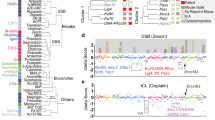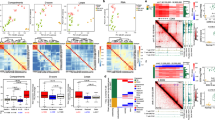Abstract
We have identified a novel gene, Translin, encoding a protein which specifically binds to consensus sequences at breakpoint junctions of chromosomal translocations in many cases of lymphoid malignancies. The encoded protein, Translin, is a previously undescribed type with no significant similarity to known proteins. In the native form, Translin polypeptides form a multimeric structure which is responsible for its DMA binding activity. Nuclear localization of Translin is limited to lymphoid cell lines, raising the intriguing possibility that nuclear transport of Translin is regulated in a physiologically significant way such that active nuclear transport is associated with the lymphoid specific process known as Ig/TCR gene rearrangement.
This is a preview of subscription content, access via your institution
Access options
Subscribe to this journal
Receive 12 print issues and online access
$209.00 per year
only $17.42 per issue
Buy this article
- Purchase on Springer Link
- Instant access to full article PDF
Prices may be subject to local taxes which are calculated during checkout
Similar content being viewed by others
References
Maziarz, R.T. et al. A γ/δ+ T cell leukemia bearing a novel t(8;14)(q24;q11) translocation demonstrates spontaneous in vitro natural killer-like activity. Blood 79, 1523–1531 (1992).
Kasai, M., Maziarz, R.T., Aoki, K., Macintyre, E. & Strominger, J.L., Involvement of the pvt-1 locus in a γ/δ T-cell leukemia bearing a variant t(8;14)(q24;q11) translocation. Molec. Cell. Biol. 12, 4751–4757 (1992).
Kasai, M. et al. Recombination hotspot associated factors specifically recognize novel target sequences at the site of interchromosomal rearrangements in T-ALL patients with t(8;14)(q24;q11) and t(1 ;14)(p32;q11). Int Immun. 6, 1017–1025 (1994).
Aoki, K. et al. Nuclear proteins binding to a novel target sequence within the recombination hotspot regions of Bcl-2 and the immunoglobulin DH gene family. Oncogene. 9, 1109–1115 (1994).
Kozak, M. The scanning model for translation: an update. J. Cell Biol. 108, 229–241 (1989).
Boehm, T. et al. Alternating purine-pyrimidine tracts may promote chromosomal translocations seen in a variety of human lymphoid tumours. EMBO J. 8, 2621–2631 (1989).
Adachi, M. & Tsujimoto, Y. Potential Z-DNA elements surround the breakpoints of chromosome translocation within the 5′ flanking region of bcl-2 gene. Oncogene 5, 1653–1657 (1990).
Lu, M., Zhang, N., Raimondi, S. & Ho, A.D. S1 nuclease hypersensitive sites in an oligopurine/oligopyrimidine ONA from the t(10;14) breakpoint cluster region. Nucl.Acids Res. 20, 263–266 (1991).
Kmiec, E.B., Angelides, K.J. & Holloman, W.K. Left-handed DMA and the synaptic pairing reaction promoted by Ustilago reel protein. Cell 40, 139–145 (1985).
Rich, A., Nordheim, A. & Wang A., H.-J Chemistry and biology of left-handed Z-DNA. A. Rev. Biochem. 53, 791–846 (1984).
Markham, R., Prey, S. & Hills, G.J. Methods for the enhancement of image detail and accentuation of structure in electron microscopy. Virology 20 88–102 (1963).
Kennedy, I.E., Barzilai, A, Kandel, E.R & Sweatt, J.D. Sequencing of proteins from two-dimensional gels by using in situ digestion and transfer of peptides to polyvinylidene dtf luoride membranes: Application to proteins associated with sensitization in Aplysia. Proc. Natl. Acad. Sci. U.S.A. 85, 7008–7012 (1988).
Omori, A. Improved microsequencing analysis and its application for the blotted protein from SDS-polyacrylamide gel electrophoresis. J. Prot. Chem. 9, 250–251 (1990).
Baron, B.W. et al. Identification of the gene associated with the recurring chromosomal translocations t(3;14)(q27;q32) and t(3;22)(q27;q11) in B-cell lymphomas. Proc. Natl. Acad. Sci. U.S.A. 90, 5262–5266 (1993).
Williams, M.E.H. & Meeker, C. omosomet(11 ;14Xq13;q32) breakpoints in centrocytic lymphoma are highly localized at the bcl-1 major translocation cluster. Leukemia 7, 1437–1440 (1993).
Zutter, M. et al. Thet(10;14)(q24;q11)of T-cellacutelymphoblasticleukemia juxtaposes the δ T-cell receptor with 7CL3, a conserved and activated locus at 10q24. Proc Natl. Acad. Sci. U.S.A. 87, 3161–3165 (1990).
Boehm, T.L., Williams, D., White, L. & Babbitts, T.H. A cluster of chromosome 11p13 translocations found via distinct D-D and D-D-J rearrangements of the human T cell receptor 5 chain gene. EMBO J. 7, 2011–2017 (1988).
Reynolds, T.C., Smith, S.D. & Sklar, J. Analysis of DNA surrounding the breakpoints of chromosomal translocations involving the p T cell receptor gene in human lymphoblastic neoplasms. Cell 50, 107–117 (1987).
Cleary, M.L., Mellentin, J.D., Spies, J. & Smith, S.D. Chromosomal translocation involving the β T cell receptor gene in acute leukemia. J. exp. Med. 167, 682–687 (1988).
Chen, S.J. et al. Ph1+bcr acute leukemias: implication of Alu sequences in a chromosomal translocation occurring in the new cluster region within the 8Cf? gene. Oncogene. 4, 195–202 (1989).
Inaba, T. et al. Fusion of the leucine zipper gene HLF to the E2A gene in human acute B-lineage leukemia. Science 257, 531–534 (1992).
Grimaldi, J.C. & Meeker, T.C. The t(5;14) chromosomal translocation in a case of acute lymphocytic leukemia joins the intedeukin-3 gene to the immunoglobulin heavy chain gene. Blood 73, 2081–2085 (1989).
Haluska, F.G., Finver, S.Y. & Croce, C.M. Thet(8;14)chromosomal translocation occurring in B-cell malignancies results from mistakes in V-D-J joining results. Nature 324, 158–160 (1986).
Dyson, P.J. & Rabbitts, T.H. Chromatin structure around the c-myc gene in Burkitt lymphomas with upstream and downstream translocation points. Proc. Natl. Acad. Sci. U.S.A. 82, 1984–1988 (1985).
Wiman, K.G. et al. Activation of a translocated c-myc gene: Role of structural alterations in the upstream region. Proc. Natl. Acad. Sci. U.S.A. 81, 6798–6802 (1984).
Hollis, G.F. et al. A variant translocation places the λ, immunoglobulin genes 3′ to the c-myc oncogene in Burkitt's lymphoma. Nature 307, 752–755 (1984).
Neri, A. et al. B cell lymphoma-associated chromosomal translocation involves candidate oncogene lyt-10, homologous to NF-κB p50. Cell 67, 1075–1087 (1991).
Meeker, T.C. et al. An additional breakpoint region in the BCL-1 locus associated with the t(11;14)(q13;q32) translocation of B-lymphocytic malignancy. Blood 74, 1801–1806 (1989).
Ngan, B.-Y., Nourse, J. & Cleary, M.L. Detection of Chromosomal Translocation t(14;18) within the minor cluster region of bcl-2 by polymerase chain reaction and direct genomic sequencing of the enzymatically amplified DNA in follicular lymphomas. Blood 73, 1759–1762 (1989).
Cotter, F., Price, C., Zucca, E. & Young, B.D. Direct sequence analysis of the 14q+ and 18q− chromosome junctions in follicular lymphoma. Blood 76, 131–135 (1990).
Chen, Q. et al. Coding sequences of the tal-1 gene are disrupted by chromosomal translocation in human T cell leukemia. J. exp. Med. 172, 1403–1408 (1990).
Chen, Q. et al. The tal-1 gene undergoes chromosome translocation in T cell leukemia and potentially encodes a helix-loop-helix protein. EMBO J. 9, 415–424 (1990).
Begley, C.G. et al. Chromosomal translocation in a human leukemic stem-cell line disrupts the T-cell antigen receptor δ-chain diversity region and results in a previously unreported fusion transcript. Proc. Natl. Acad. Sci. U.S.A. 86, 2031–2035 (1989).
Lu, M., Gong, Z., Shen, W. & Ho, A.D. The tcl-3 proto-oncogene altered by chromosomal translocation in T-cell leukemia codes for a homeobox protein. EMBO J. 10, 2905–2910 (1991).
Kagan, J. et al. Clustering of breakpoints on chromosome 10 in acute T-cell leukemias with the t(10;14) chromosome translocation. Proc. Natl. Acad. Sci. U.S.A. 86, 4161–4165 (1989).
Ellisen, L.W. et al. TAN-1, the human homolog of the Drosophila Notch gene, is broken by chromosomal translocations in T lymphoblastic neoplasms. Cell 66, 649–661 (1991).
Russo, G. et al. Molecular analysis of a t(14;14) translocation in leukemic T-cells of an ataxia telangiectasia patient. Proc. Natl. Acad. Sci. U.S.A. 86, 602–606 (1989).
Chen, S.J. et al. Structural alterations of the BCR and ABL genes in Ph1 positive acute leukemias with rearrangements in the BCR gene first intron: further evidence implicating Alu sequences in the chromosome translocation. Nucl. Acids Res. 17, 7631–7642 (1989).
9. van der Feltz, M.J.M. et al. Nucleotide sequence of both reciprocal translocation junction regions in a patient with Ph positive acute lymphoblastic leukaemia, with a breakpoint within the first intron of the BCR gene. Nucl. Acids Res. 17, 1–10 (1989).
Author information
Authors and Affiliations
Rights and permissions
About this article
Cite this article
Aoki, K., Suzuki, K., Sugano, T. et al. A novel gene, Translin, encodes a recombination hotspot binding protein associated with chromosomal translocations. Nat Genet 10, 167–174 (1995). https://doi.org/10.1038/ng0695-167
Received:
Accepted:
Issue Date:
DOI: https://doi.org/10.1038/ng0695-167
This article is cited by
-
Biochemical characterization of clinically relevant mutations of human Translin
Molecular and Cellular Biochemistry (2023)
-
Translin: A multifunctional protein involved in nucleic acid metabolism
Journal of Biosciences (2019)
-
C1D family proteins in coordinating RNA processing, chromosome condensation and DNA damage response
Cell Division (2016)
-
A central role of TRAX in the ATM-mediated DNA repair
Oncogene (2016)
-
Characterization of a plant (rice) translin and its comparative analysis with human translin
Planta (2014)



